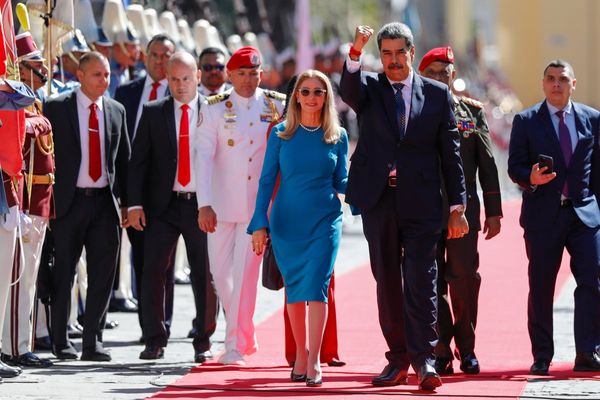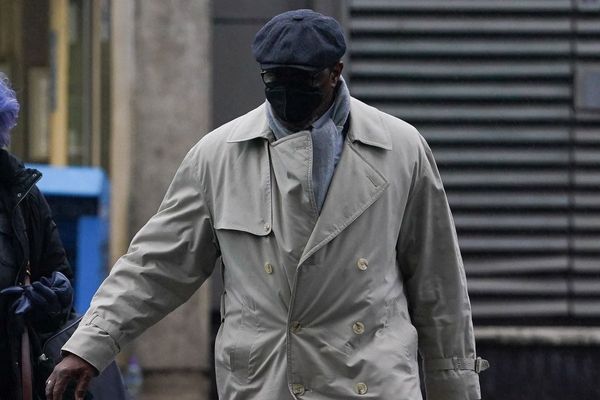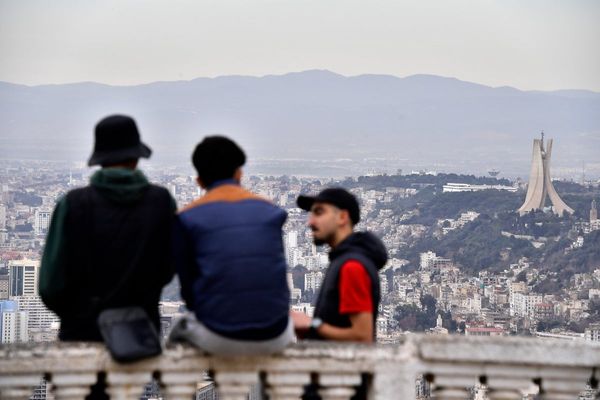Nature Talks has announced the winners of the Nature Photographer of the Year 2023 competition! The top honor goes to Jacquie Matechuk from Canada for her captivating photograph "He Looks to the Heavens", capturing a bear on a tree. Marco Gaiotti, the head of the jury, talks about the winning image: "Spanish moss is always a beautiful, very photogenic subject, and often alone they are able to offer visually interesting compositions, both from the point of view of color and texture. The silhouette of an Andean bear crossing the Spanish moss hanging from an ancient tree is something that goes beyond the most vivid dreams of a nature photographer."
Other than the main winner, there were also some other impressive photographs recognized in the Nature Photographer of the Year 2023 competition. Scroll down to take a look at this year's winners, runners-up, and highly commended photos! Don't forget to upvote your favorite ones and share your thoughts in the comments!
More info: naturephotographeroftheyear.com | Instagram | Facebook
#1 Overall Winner: "He Looks To The Heavens" By Jacquie Matechuk, Canada
"Spanning more than 8,000km, the Andean Mountain range occupies more than a quarter of the land surface in Ecuador. Rich in biodiversity, it’s also home to a unique species called the Spectacled bear. Until planning this trip, I knew nothing of them. But as a certified bear guide, I was excited to expand my knowledge and understanding of a new species and to compare behavior and their interactions to those of our grizzly, polar, black, and brown bears. As we drove from Quito to the Andean mountains, through villages and farming communities, the extraordinary conditions and fertility of this land were inescapable. Hours of winding roads and stunning landscapes later, we pulled into a small community where we were greeted by a local farmer/guide. A gentle-natured man who’s worked tirelessly for decades to observe, learn, and advocate for this endangered species. His family’s hospitality reaching far beyond opening his home, opened a door to a whole new world. For 11 days at roughly 8,000 feet above sea level, we hiked vertical paths up and down the canyon walls, trekking through creeks, ducking out of torrential downpours, and often clambering through mud to observe these beautiful bears. In their natural habitat and with our guide’s intimate knowledge of each bear, we were quickly accepted by them. We kept a respectful distance to ensure their comfort and it paid off in spades. They would nurse, fall asleep, cuddle, forage, and play, seemingly more oblivious to our presence with each passing encounter. In this image, Tony (a large male spectacled bear), and frequent traveler through these parts had climbed into a century-old fig tree seeking refuge from the midday sun. It was draped in Spanish moss, gently swaying with each breath inhaled and exhaled by the canyon walls. He sauntered effortlessly across a burly branch and sat peacefully against the tree’s trunk. When a gentle rain began to fall across the valley, he stood and turned to look up as though embracing the cool moisture on his speckled face. And for a fleeting moment, the warmth of muted sunlight falls across his face as ‘He Looks to the Heavens’."

Image credits: Nature Photographer of the Year (NPOTY) 2023
Members of this year’s judging panel were:
- Marco Gaiotti (ITA), chair of the judging panel;
- Ellen Cuylaerts (BEL);
- Stefan Gerrits (NED/FIN);
- Gheorghe Popa (ROM);
- Tin Man Lee (USA).
To select category winners, the judges were looking at factors such as artistic brilliance, captivating composition, and the ability to convey a profound sense of artistic maturity. The jury members also took into account the photographers' skills in capturing decisive moments, creating thought-provoking narratives, and showcasing rare movements in nature. Overall, the selected images showcased exceptional creativity, technical excellence, and storytelling abilities demonstrated by the photographers across various categories.
#2 Category Birds: Winner, "Dawn's Whispers: Graceful Hoopoe Silhouette At Sunrise" By Hermis Valiyandiyil, United Arab Emirates
"This picture of Hoopoe was taken in Dubai from Al Qudra Lakes. I spend most of my weekends taking pictures of the birds in Al Qudra Lakes. I wanted to test my new Nikon Z8 camera. So, my friend and I traveled to the lake where I noticed a Hoopoe occasionally catching its prey in the air and at other times on the ground. Additionally, I observed that each time it caught prey, it flew in the same direction to a nearby tree. I spent a few days photographing this bird, and when I got home and looked over the pictures, I got the idea to photograph the bird against a background with light and dark sides to represent the dark and light sides of existence. The following day, I arrived a little earlier at the same location and waited for the ideal shot to occur."
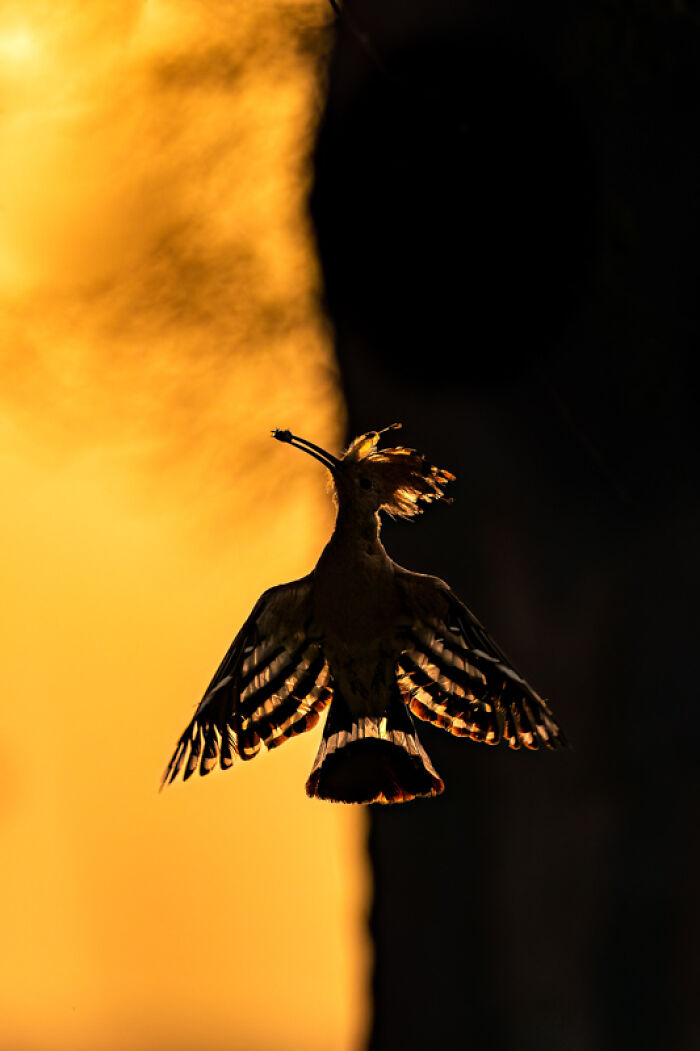
Image credits: Nature Photographer of the Year (NPOTY) 2023
#3 Category Mammals: Highly Commended, "Follow The Leader" By Torie Hilley, USA
"Mother coastal brown bears (Ursus arctos gyas) and cubs are constantly on the lookout for male bears that will kill the cubs to mate with the mother to pass on their own genes. To see a bear cub is special, but to see THREE with one mother is extra special. I had the privilege to encounter these three little ones in Lake Clark National Park and Preserve in Alaska, USA. While with a professional bear guide, I followed them with their mother on the mudflats as they dug for clams, hoping to catch them in a line. For several days, I trudged through the thick, sticky mud in hopes of this shot. On the last day, I saw the cubs start to line up. I dropped to one knee into the mud and hovered my massive lens over the mudflat to blur out the foreground, creating an other-worldly feel. Patience can pay off, and I was thrilled to capture this behavior, especially with all three in step with one another. Back home and ecstatic to have achieved my goal, I, unfortunately, heard that all three cubs didn’t survive the upcoming weeks. Heartbroken to hear this, it reminded me to never take anything for granted and to enjoy nature’s beauty as much as possible in that moment because you never know what happens next."
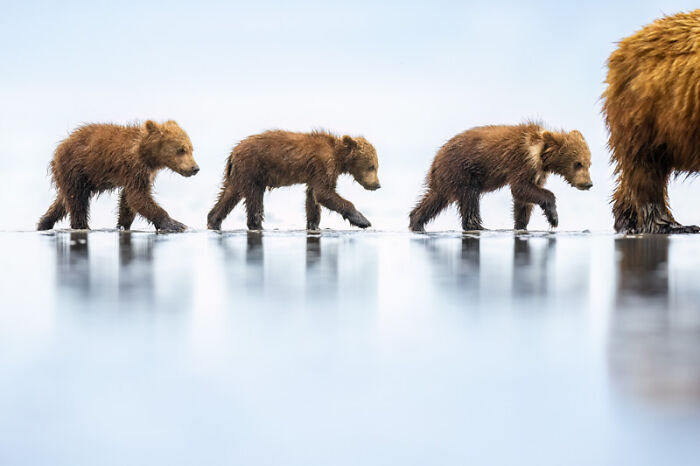
Image credits: Nature Photographer of the Year (NPOTY) 2023
Nature Talks, the organizer of the Nature Photographer of the Year competition, is an all-around event for nature photography. They cover a wide range of genres like macro, landscape, underwater, wildlife and storytelling. Nature Talks isn't just about the competition; it's also an event with interesting talks by top photographers, live Q&A sessions, masterclasses, and reviews of portfolios and photos. The Nature Talks Photo Festival for 2023 took place on November 11th and 12th.
#4 Category Mammals: Highly Commended, "Amur Leopard" By Sergey Gorshkov
"Amur leopard. The photo was taken in the national park 'Land of the Leopard' for a photo project. I like to photograph a leopard in the snow."
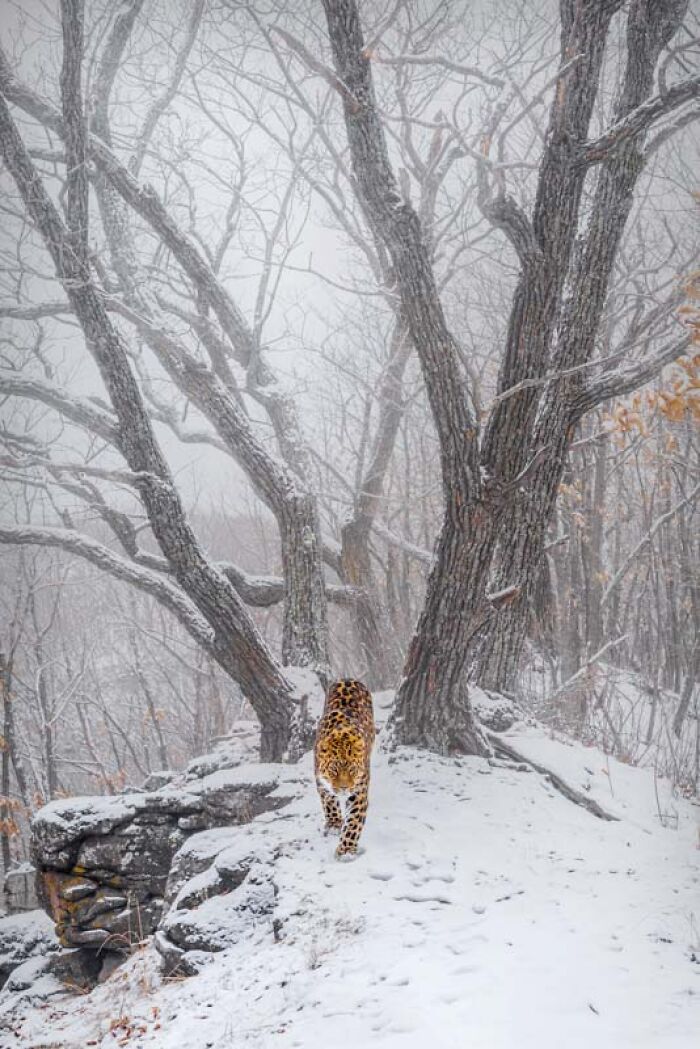
Image credits: Nature Photographer of the Year (NPOTY) 2023
#5 Category Animals Portraits: Highly Commended, "The Look" By Henley Spiers, United Kingdom
"Life as an underwater wildlife photographer mostly involves trying to very gently accustom animals to our presence. As photography through water requires extreme proximity, we are usually unable to completely conceal ourselves from the wildlife and cannot rely on long lenses or hides to aid in fieldcraft. Blissfully, the California sea lion pups at this marine protected area require no such strategies, as they actively seek out interaction…curiously checking out human visitors with playful enthusiasm. Placing myself at the end of this underwater cavern beneath a sea lion colony, I had to wait less than a minute before this pup came to investigate. Location: Espiritu Santo National Park, Baja California Sur, Mexico."
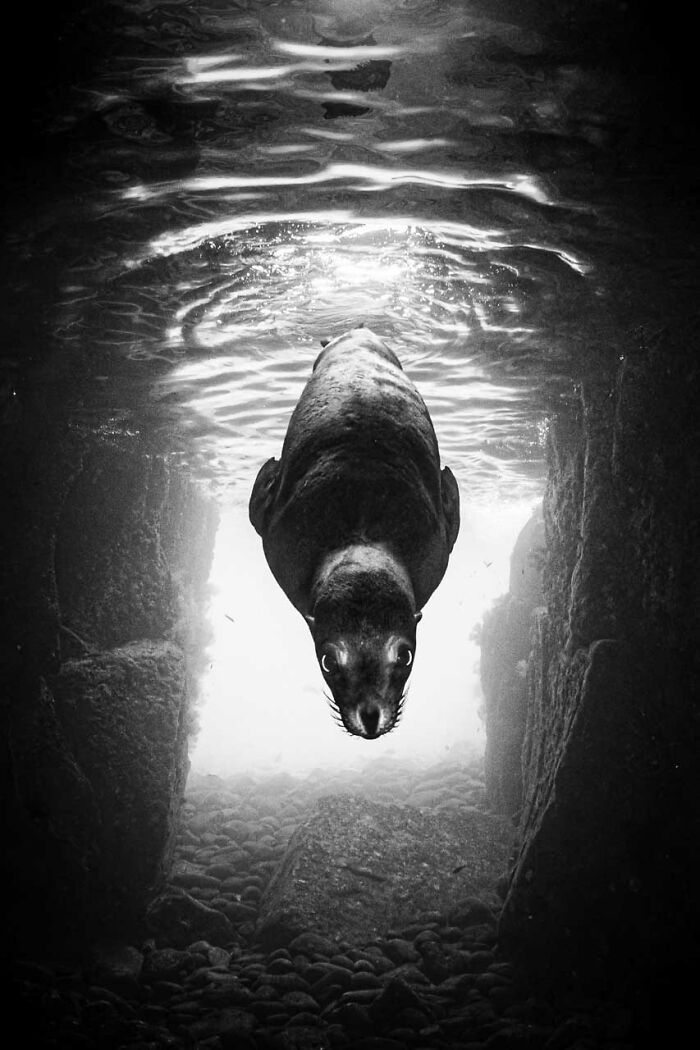
Image credits: Nature Photographer of the Year (NPOTY) 2023
The NPOTY contest also supports NGOs or other organizations who step forward to help nature. With this year's edition, they support Photographers Against Wildlife Crime™.
#6 Category Black And White: Highly Commended, "Graceful Turn" By Richard Li, USA
"Capturing the Majesty of a Kenyan Night. Lentorre, nestled alongside the Maasai Mara grasslands in Kenya, is a highland region known for its breathtaking natural beauty. However, in recent years, it has been experiencing the harsh impacts of the monsoon and the effects of global climate change, resulting in prolonged periods of scorching, arid weather. Last October, I found myself back in this remarkable place, taking shelter beside a small waterhole, poised to capture the enchanting nocturnal moments of wild animals quenching their thirst. During the first half of the night, the waterhole attracted a diverse array of creatures – antelopes, zebras, giraffes, porcupines, and mongooses. Yet, as the latter half of the night approached, an eerie stillness fell over the water, signaling that something extraordinary was about to unfold. Indeed, it did. Emerging gracefully from the obscurity of the thicket, a colossal adult leopard made its grand entrance. As the apex predator, it displayed none of the timidness seen in herbivorous animals and seemed unfazed by the floodlights we had carefully positioned. Slowly and deliberately, it patrolled the water’s edge, casting a flawless reflection in the tranquil pool. When it reached a sinuous tree at the water’s edge, it executed a graceful pivot. At that moment, I pressed the shutter button, capturing the epitome of elegance in the Kenyan night."
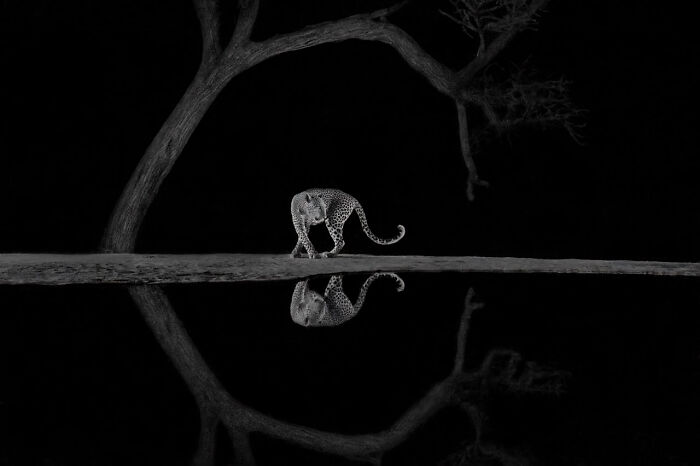
Image credits: Nature Photographer of the Year (NPOTY) 2023
#7 Category Nature Of “De Lage Landen”: Runner-Up, "Green Triplets" By Johan De Ridder, Belgium
"Several years ago, during a hike in the Flemish region near Ghent, I found a human-made natural pond. This pond was abandoned for years, overgrown, and almost invisible to the eye, never removed by the original owner. When I arrived it was already late and getting dark. Being tired from my long walk I sat down and watched what was going on in this small fascinating world. Suddenly some lights in the pond were automatically activated. Who put on the lights? These lights were still there, forgotten below the surface, loaded by solar power cells hidden in the overgrown weeds. Suddenly, attracted by the lights, some alpen water salamanders (Ichthyosaura alpestris) appeared. At first one, then two, and then lots of them… what a surprise. This gave me an idea and I would be back with my gear, later that week. With only my trusty Nikon, macro lens, and swimming trunks, I went into the pool that was luckily only 50cm deep. Just enough to get my subjects in focus. I always had to wait until it was dark enough, so the lights went on. This took a lot of time, back pain, mosquito bites, and more than 300 shots, resulting in only 5 acceptable pictures. Each time I made a small move, all the animals disappeared for several minutes and I had to start all over again. And yet, they always came back. Out of curiosity and also because they are using the light to hunt for small insects, snails, or larvae. A few days later the pond was removed and a new house was built in this location… very sad for these small creatures. Always grasp the opportunity when it comes your way."
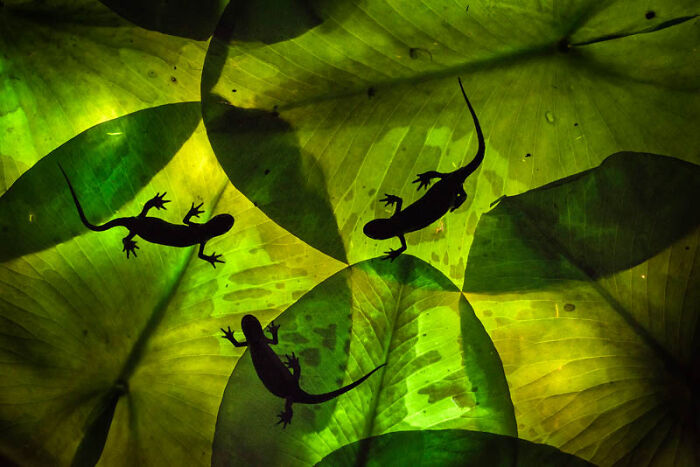
Image credits: Nature Photographer of the Year (NPOTY) 2023
#8 Category Human And Nature: Runner-Up, "No Land For Leopards" By Pruthvi B, India
"Leopards (Panthera pardus fusca) are some of the most elusive and adaptable big cats in India. Habitat loss due to rapid urbanization has pushed these big cats close to human habitation. Most of the time, farmlands and human settlements are used by these cats to hunt small mammals, poultry, other farm animals, and stray or free-roaming dogs. These majestic cats are listed as vulnerable on the ICUN Red list. “No Land for Leopard” has been an ongoing project for 5 years as part of capturing urban wildlife through camera trapping in and around Mysore in south India. This image is part of the series. This camera trap image was the result of months of tracking and planning. Monitoring its movement, its frequency, and the regular path that it used was determined. Finally, a DSLR camera trap was placed. The biggest challenge was the weather; it was the start of monsoon season. The main idea for this frame was to show how close these cats move around human habitation without being noticed. It also shows the elusive nature of the leopard, redefines human-wildlife boundaries, and reiterates that ‘we humans live in a shared space’."
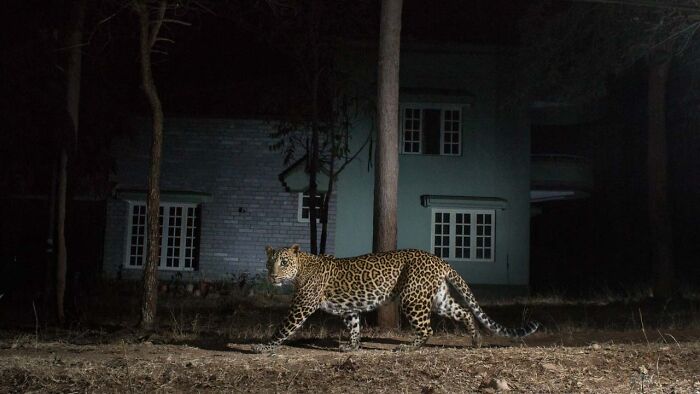
Image credits: Nature Photographer of the Year (NPOTY) 2023
#9 Category Mammals: Runner-Up, "Shaking Off The Cold" By Jeffrey Kauffman, USA
"One of the reasons I am so happy this photo won is because the story behind it is very interesting. One of my lifelong dreams was to see polar bears in the wild. Last year I set out for Churchill, Manitoba in Canada to photograph polar bears for the first time. I had a very productive trip, taking thousands of photos of polar bears and foxes. I was very happy with the whole trip. When it came time to leave Churchill, there was a slight problem. A massive blizzard had fallen on Churchill with 30-50 mph winds and freezing temperatures. All flights were canceled that day. Everyone was worrying about what to do, how to get home, connecting flights, etc… Our guides quickly told us to get in the vehicles because they spotted a bear along the Hudson Bay coast. All worries about missing the flight just vanished. Driving in blizzard conditions, we approached the polar bear sitting in the snow in front of a sand dune covered with snow. We all got out of the vehicles and started taking photos. The wind was so strong it was impossible to handhold or even use the tripod without having the camera shake! I ended up using the rearview mirror and the body of the truck we were in to keep the camera steady as I pressed myself and the camera against the truck body as hard as I could. I noticed every 10 -15 minutes the bear would rise out of the snow and shake off. I tried different shutter speeds to get the right feel for the photo. I found that a very low shutter speed blurred the fast-moving snow and made the background more uniform."
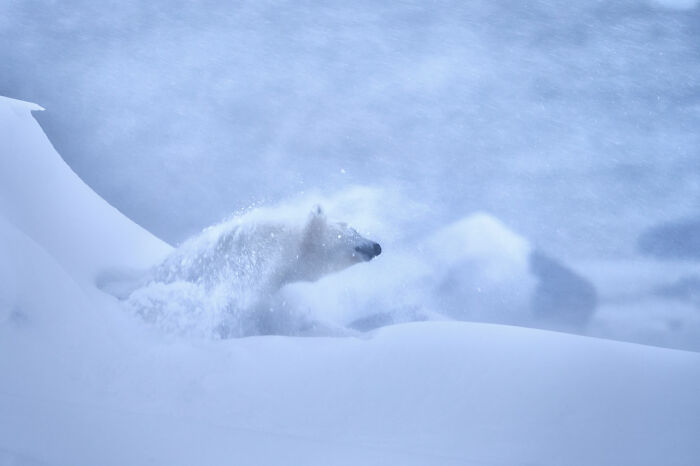
Image credits: Nature Photographer of the Year (NPOTY) 2023
#10 Category Mammals: Highly Commended, "Wolf And Iceberg" By Christophe Vasselin, Luxembourg
"The Arctic wolf (Canis lupus arctos) is for me the most elusive and iconic arctic animal. This wolf lives exclusively in the Canadian High Arctic. Meeting it requires a lot of organization, logistics, physical engagement, patience, luck, and a competent Inuit team. We were on Ellesmere Island, the northernmost point of land in Canada and one of the most northern points of land on the planet, looking for wildlife for 10 days when we met this wolf. We had set up our base camp near an iceberg trapped in the ice floe. In the morning, one of our guides told us that they had spotted a wolf eating a baby seal. Happily, the wolf decided to eat the prey very close to our camp, and without disturbing him during his meal, we observed it for 2 hours. Then, he decided to leave and passed just in front of the incredible blue iceberg. A perfect shot and an unforgettable moment."
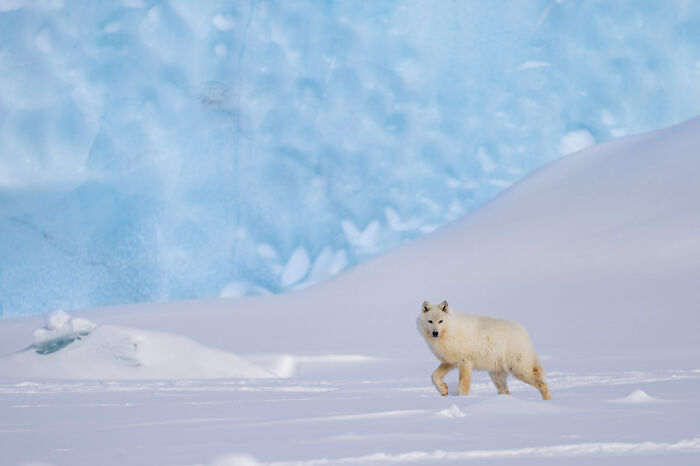
Image credits: Nature Photographer of the Year (NPOTY) 2023
#11 Category Underwater: Winner, "Paper Nautilus Rider" By Renee Capozzola, USA
"This image of a paper nautilus with jellyfish was shot off Anilao in Balayan Bay, Batangas, Philippines with a 60mm lens during a Blackwater dive. During this type of dive, which is performed over very deep water at night, divers search for tiny critters with handheld torches while circling a lit downline. Towards the end of my dive at approximately 10-15 meters of depth, I spotted this paper nautilus or Argonaut, which is often seen riding on the back of a jellyfish. This paper nautilus is a female as it features a thinly secreted coiled shell or egg case which resembles a hat. These unique cephalopods rise towards the surface at night to feed and in this case, aerate their eggs."
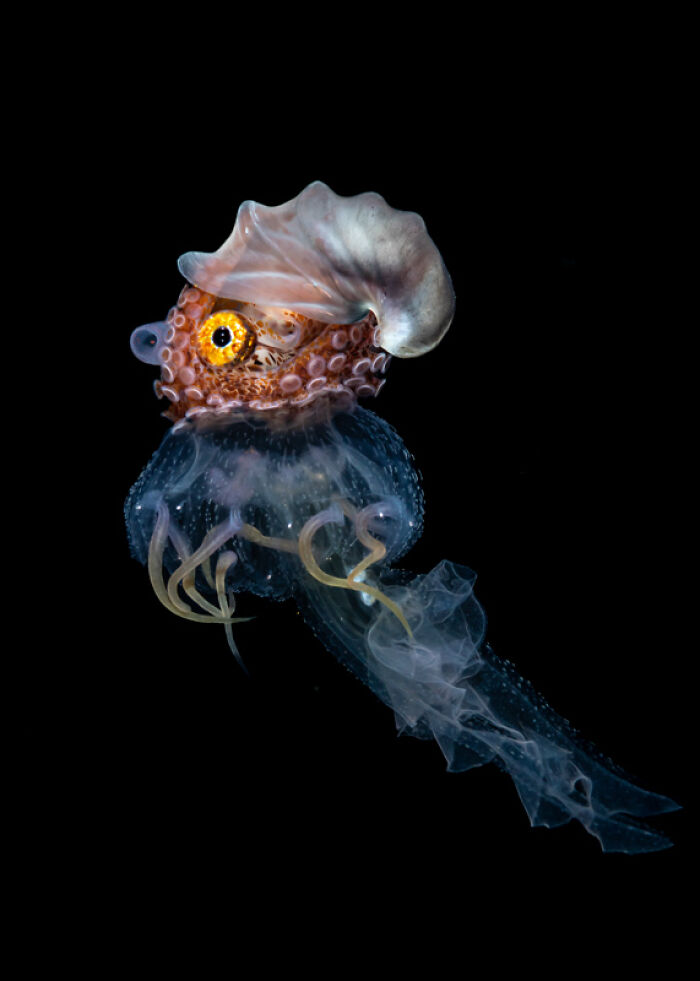
Image credits: Nature Photographer of the Year (NPOTY) 2023
#12 Category Black And White: Highly Commended, "Mobula Ray Fever" By Martin Broen, USA
"Every year there’s an aggregation of mobula rays in Baja California, Mexico. An amazing moving fever of rays that create an immense dynamic pattern of light reflections underwater. You don’t get to distinguish the individuals but a single mass. For a week been trying different techniques underwater, half and half, as well as top side as mobula jumps quite high out of the water as part of their social ritual.
During the morning, the sun was penetrating the water at an angle that allowed for a show of fluctuating light rays that somehow complemented the moving texture of the mobulas, and provided even more volume to the photo. After getting some good detail shots of a few individuals reaching toward the sun, I became obsessed with capturing a dramatic shot of the full group and showcasing its massive size, but after several attempts, I realized that at the proximity dictated by the water visibility, not even my fish-eye lens will fit all of them in a single frame. So fitted my rectilinear wide-angle lens in the underwater housing and attempted a x6 shot panorama, doing it fast enough that allow me to stitch that moving mass. And getting them framed by the morning rays."
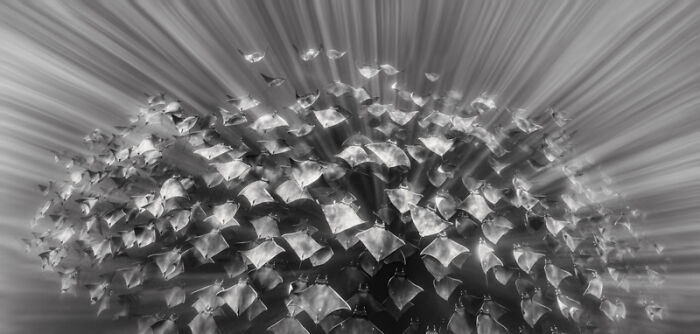
Image credits: Nature Photographer of the Year (NPOTY) 2023
#13 Category Black And White: Highly Commended, "Swimming Underwater" By Risto Raunio, Finland
"I am keen on penguins, and my dream is to have pictures of all (17-18) penguin species in the world. On January 2023 I was on the journey heading to Antarctica. We started our trip from New Zealand and on the way heading to the Ross Sea, I was lucky to see six different penguin species on a few islands of the Subantarctic area. Sailing carefully through drift ice in the middle of Ross Sea, I noticed that a few Adelie penguins were swimming in the sea behind and on both sides of our ship. They either swam in the water or run on the ice floes, which was funny, but also amazing to see. The left side of the ship was luckily in shadow where it was possible to see underwater without a polarized filter. On the deck of our ship, I followed a penguin that swam occasionally just a little bit underwater. This wonderful show lasted only two or three minutes, but I was lucky to have many pictures of this lovely bird and of this rare photo situation. Converting this picture from the original RAW to jpg format I was sure the black and white version looked much better than the same picture in colors."
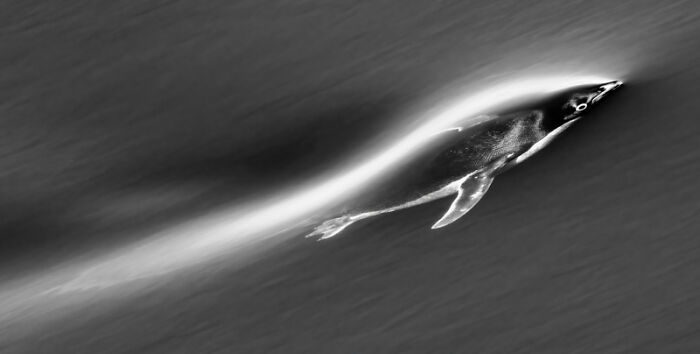
Image credits: Nature Photographer of the Year (NPOTY) 2023
#14 Category Youth: Highly Commended, "Lantern Gecko" By Anton Trexler, Germany
"The gecko sits in the lamp. Light attracts insects, which are the gecko’s food source. Even though light pollution kills countless insects every night, this image shows an interesting interplay in which animals benefit from our civilization through adaptation."
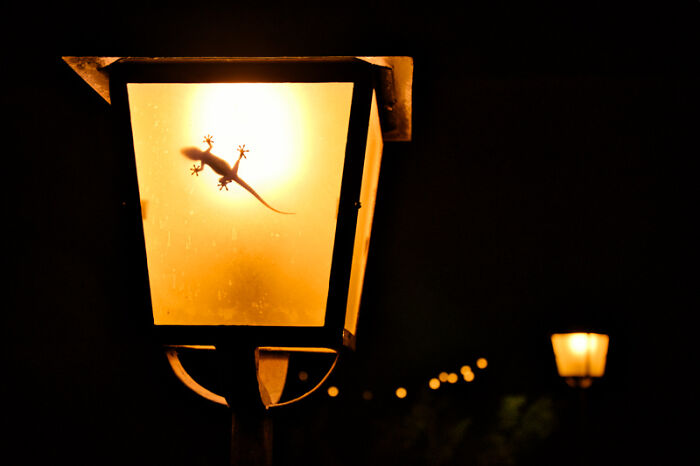
Image credits: Nature Photographer of the Year (NPOTY) 2023
#15 Category Nature Art: Winner, "Fields Of Dreams" By J Fritz Rumpf, USA
"On one of my first wild mushroom foraging outings, in the White Mountains of Arizona, USA, I went with a friend who taught me how to identify two types of edible mushrooms (Boletes and Caesars), I walked by this mushroom who was lying upside down on the ground. The stunningly vibrant colors of the gills caught my attention. I proceeded to set up my tripod, and using my photo backpack as a base, took several photo stacks, using the beautiful natural soft forest light. Once I got home and processed the photo stacks, I chose this resulting image and proceeded to crop it in a way where it was not immediately obvious what the subject was. As far as I remember, not a single person guessed that this was the image of the underside of a mushroom. It was interesting what people saw in this image: some likened it to waves crashing onto a cliff, others thought of rays radiating off of a distant planet, a desert landscape of furrowed canyons, and my favorite, an underwater scene in the ocean. In the process of identifying the mushroom, I found that the blue/green color might indicate the presence of psilocybin or psilocin, chemical compounds found in psychedelic mushrooms, hence the name; “Fields of Dreams”. In the end, the overwhelming consensus was that this beautiful fungi was part of the Lactarius, or Milk Cap, family. The big lesson I learned through this image, is to slow down in nature, and not only take in its beautiful grand vistas but look for and appreciate all the small gems hidden within. So much beauty we often simply walk by, without appreciating all the small marvels created by Mother Nature. This is a photo stack of 19 images, using the back of my photo backpack as a base, and making use of the stunning, soft forest light. (I honestly don’t remember, but I might have used the cellphone flashlight to accentuate the colors ever so slightly)."
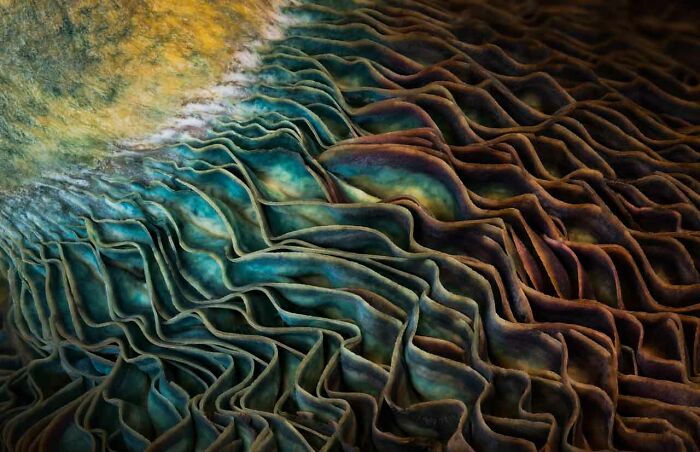
Image credits: Nature Photographer of the Year (NPOTY) 2023
#16 Category Landscape: Runner-Up, "Sunset" By Jens Lax, Finland
"In the summer I live at my summer cottage by the sea in Oravais, Finland. I see beautiful sunsets almost every night. Yes, it is beautiful with sunsets in the sea. But there are usually hundreds of pictures of sunsets appearing on social media every night. So I thought I’d experiment with making a slightly different sunset image. I started by testing different double exposures but then I realized that if I turn the camera upside down in one of the images, I get a small effect of a reflection. And that’s how this picture came about."
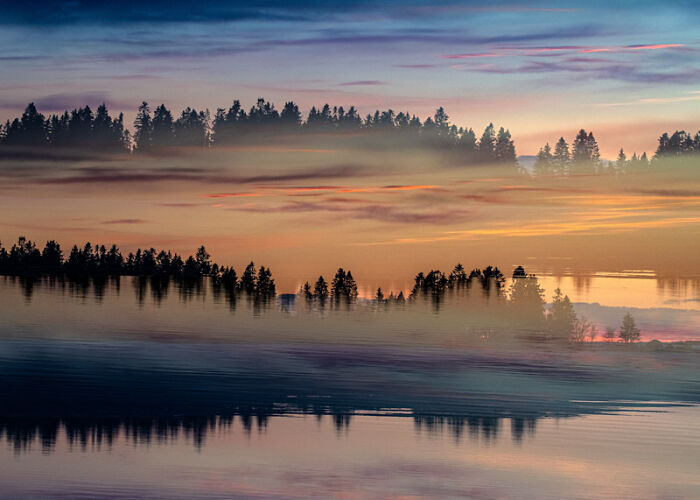
Image credits: Nature Photographer of the Year (NPOTY) 2023
#17 Category Black And White: Winner, "Heads Or Tails" By Jodi Frediani, USA
"I am most fortunate to live adjacent to the Monterey Bay National Marine Sanctuary (off the coast of California), considered to be the top hot spot for biodiversity in North America. The bay is a prime feeding ground for multiple species of whales, dolphins, porpoises, sea birds, and smaller sea creatures. I am also quite fortunate to have unlimited access to whale watch boats and can go out on the bay whenever I choose. When I do, however, I rarely stand at the bow, a prime location for watching bow-riding dolphins, as I know each trip may be the only chance most passengers will ever get to witness such amazing behavior. This image was made possible by the extraordinary generosity of a young, female whale watcher. On that beautiful sunny and wind-free morning, I came up to the bow to see a friend who was excitedly leaning over the rail, and I realized the rare, calm sea conditions, combined with these gorgeous dolphins, were ideal for some special images. But the bow was crowded, and there was no room for me. The young woman in question saw my interest and camera and graciously offered me her spot at the rail. I politely declined, but she insisted, so I gratefully accepted. I was stunned by the scene unfolding below me. When we later disembarked, I sought her out and thanked her again, as I realized I had gotten some rather remarkable and unique images. I am forever indebted to this generous, thoughtful stranger. In this photograph, three northern right whale dolphins (Lissodelphis borealis) were bow-riding the pressure wave of our whale watch vessel. Exceptionally rare, clear, flat seas provided a smooth, colorful palate to showcase these slender, sleek, and streamlined cetaceans. Mostly black, these gregarious dolphins are atypical in appearance with short, pointy beaks, sloping foreheads, and no dorsal fins. They are extremely athletic, often flying high out of the water in graceful leaps. They are lightning quick, and able to swim at an average speed of 16 mph. And best of all (for us!), they love to ride the bows of ships. Monterey Bay National Marine Sanctuary, Monterey Bay, California, USA."
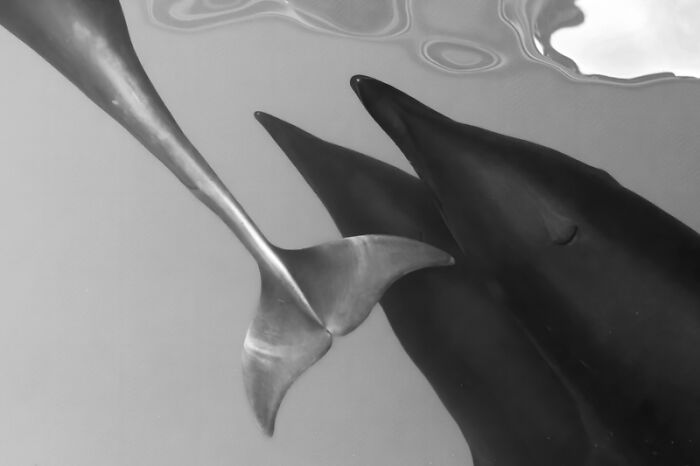
Image credits: Nature Photographer of the Year (NPOTY) 2023
#18 Category Animals Portraits: Runner-Up, "Scrub Hare" By Paul Mckenzie, Hong Kong
"When one travels on a photographic safari to Africa, the temptation is to focus on the megafauna species such as elephants, lions, leopards, and cheetahs. But there are other smaller, less glamorous and far less photographed species present. Some of these are nocturnal and rarely photographed such as this Scrub Hare. Their most distinctive feature are their giant ears allowing for acute hearing which helps them to evade predators. The ears are not especially photogenic with regular front lighting but take on a life of their own when backlit such as this individual at a water hole in southern Kenya."
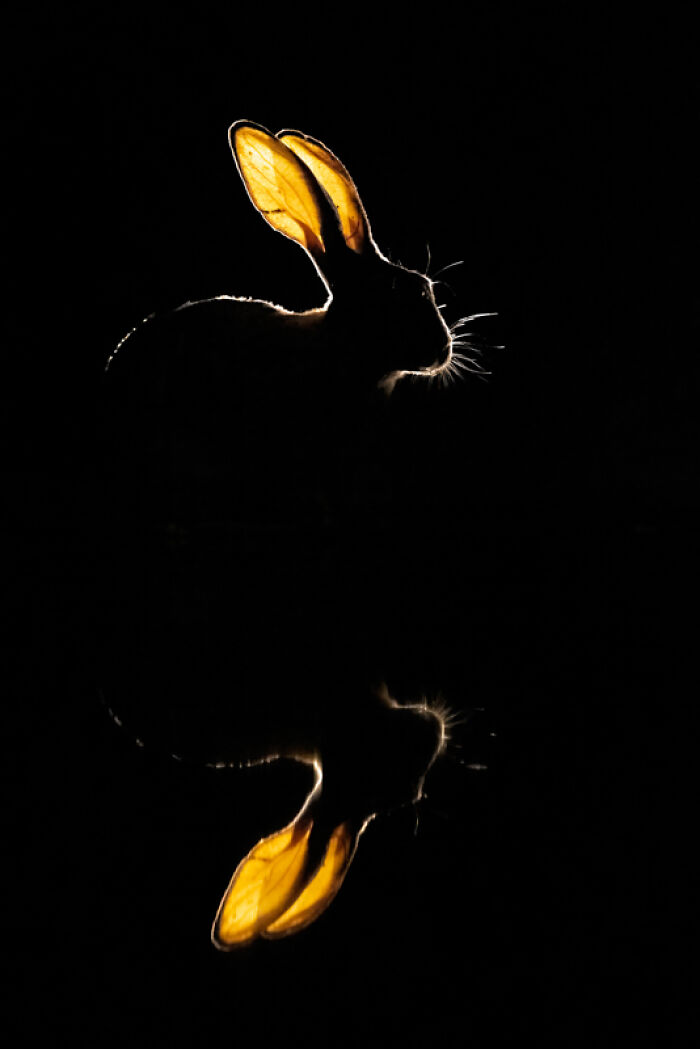
Image credits: Nature Photographer of the Year (NPOTY) 2023
#19 Category Black And White: Runner-Up, "The Charge" By David Gibbon, United Kingdom
"In March 2022, after three years of planning, I went to Ellesmere Island in the Canadian High Arctic. I and four others traveled across this extreme environment to find and photograph arctic wolves, musk ox, and other arctic wildlife. We experienced cold well below -50 degrees but came home with images of arctic hares and little else. In March 2023 I tried again. On this trip, not only did we find arctic wolves, but I also had this incredible experience with a herd of musk ox.
I lay flat on the ground, as the temperature dropped below -40, watching this herd charge but from quite a distance away. Knowing they could trample me to death, as some musk ox bulls can weigh up to 400kg each, it was a real test of nerve as they approached me at full speed. To make sure they did not know I was there, I continued to stay flat to the ground. In order to capture the image I removed my down gloves and was just wearing very a thin glove base layer. At this point, my hands were so cold I could not physically use my camera finger to press the shutter so I was forced to take the image with my middle finger. As they got closer, I quickly stood up and, thankfully, the herd changed direction and ran past me. It all happened so quickly that I did not have time to check my shutter speed, which had dropped to just 1/250. But luckily this image – out of many images I had taken – was sharp."

Image credits: Nature Photographer of the Year (NPOTY) 2023
#20 Category Youth: Highly Commended, "When The Nightlife Awakens" By Anton Trexler, Germany
"I was used to photographing the garden dormice in my hometown near Frankfurt for years and I have spent several evenings and nights outside, just watching these little hyperactive animals climbing down the ladder of my attic when the sun sets down and the city begins to sleep. The science is still not clear, why the Garden dormice population is decreasing so they have become very rare. The animals are used to the lights and they don’t care about it anymore."
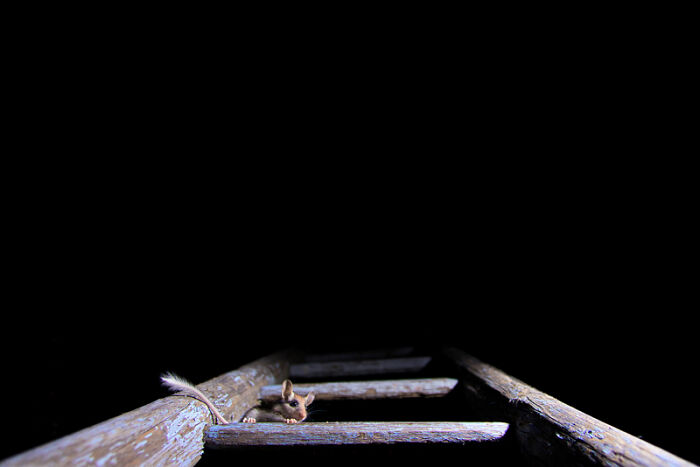
Image credits: Nature Photographer of the Year (NPOTY) 2023
#21 Category Underwater: Runner-Up, "Alpensalamader" By Luc Rooman, Belgium
"For many years, I have followed the amphibian migration as I did this year. In spring, the amphibians migrate en masse to the water to mate, as was also the case this year. Carefully I started searching among the stems of the growing water lilies and with success. Carefully I approached the salamander and took a whole series of photos. After a while, the salamander had had enough and made its way to the surface. Quickly I took a few more photos of the silhouette of the swimming salamander and on reflection, the photo was ideal for making a double exposure in the camera."
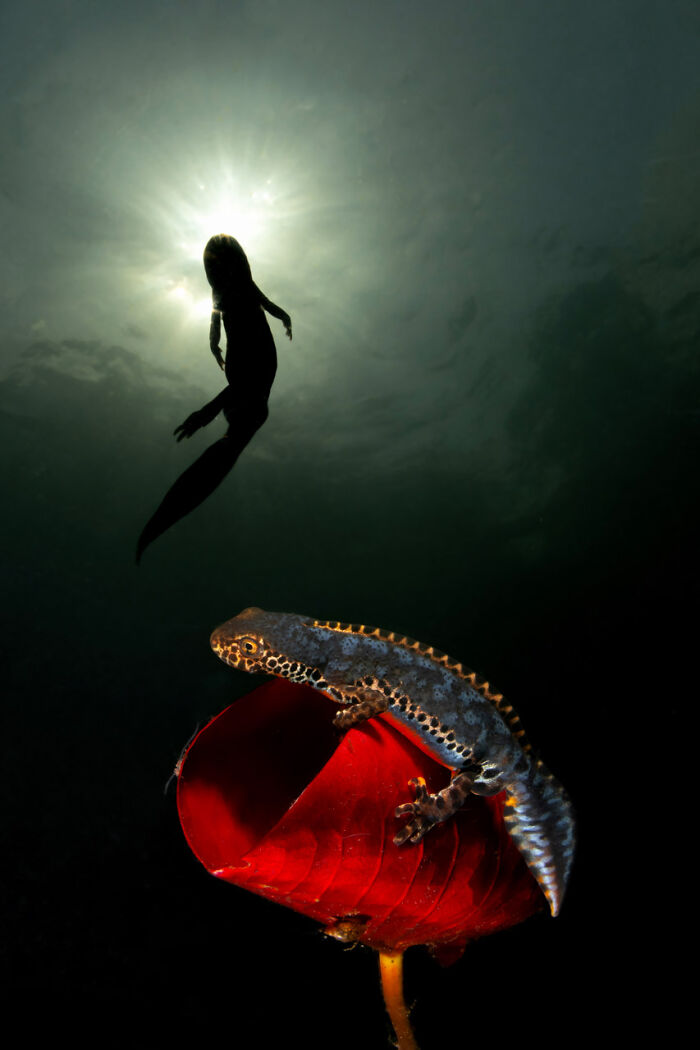
Image credits: Nature Photographer of the Year (NPOTY) 2023
#22 Category Underwater: Highly Commended, "Pike" By Luc Rooman, Belgium
"In the spring in May, the water lilies start to grow quite a bit but the stems are not so close together yet. Ideal to look for fish hiding between the stems then. This photo was taken in the freshwater lake De Melle near Turnhout (Antwerp) where there is a large population of water lilies. After a while, I noticed this large pike among the stems which I approached carefully and thus was able to take a whole series of pictures. Taking pictures of pike is very easy as they have no natural predators in the lake and stay calm if you approach them carefully which is also the case with this pike."
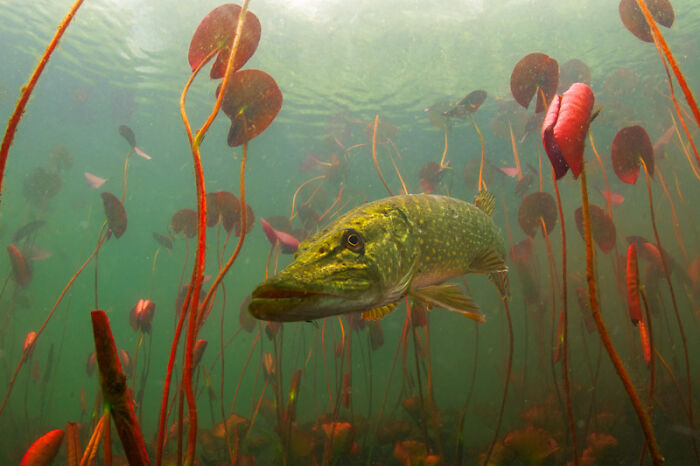
Image credits: Nature Photographer of the Year (NPOTY) 2023
#23 Category Human And Nature: Highly Commended, "Ghost In The Darkness" By Wim Van Den Heever, South Africa
"For almost 10 years I have been visiting Kolmanskoppe in Namibia. This abandoned Ghost Town that used to be a diamond mine is slowly being reclaimed by the harsh Namib desert. From day one I have always dreamt about a photograph of an elusive and endangered Brown Hyena prowling the abandoned streets at night. I only once saw a set of Hyena footprints next to the ruins, but I knew the area was known for fairly good Brown Hyena activity. I spoke to the security guard at the entrance of the Ghost Town about the frequency of sightings within the Ghost Town. He told me that they pass through every 4 to 6 weeks on average so I knew there was always going to be a possibility. Every single time I visited the Ghost Town I’d set up camera traps in the hope of success. It took me 10 years to finally get this one single image of a Brown Hyena in the most perfect frame imaginable. I was ecstatic when I finally had success."
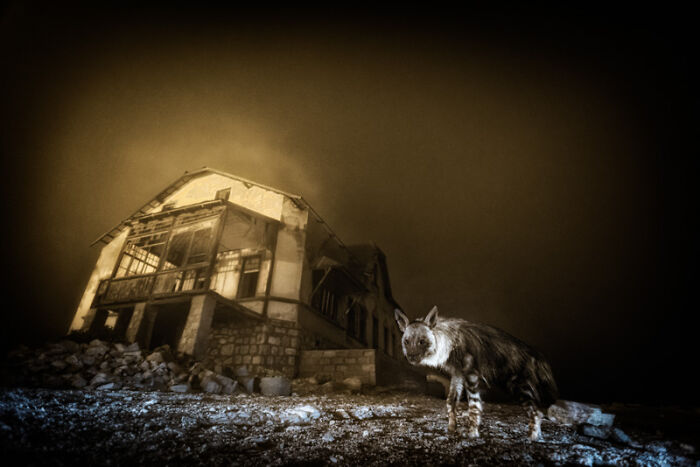
Image credits: Nature Photographer of the Year (NPOTY) 2023
#24 Category Human And Nature: Highly Commended, "Threatened By The Highway" By Geoffrey Reynaud, Canada
"Every year a small herd of the threatened wood Bison in northern British Columbia suffer from road collision. When winter arrives, sometimes the snow is so deep the Wood Bison herds that inhabit the forest along the Alaska Highway tend to use the free-of-snow highway to move from one grazing area to another. Their journey is difficult, and many bison will succumb to the traffic. Records show that annually about 15 percent of the population in the region dies as a result of these collisions. Throughout my journeys into northern Canada, I encountered numerous distressing roadkill incidents as I ventured along this same highway. The devastating fate suffered by these magnificent creatures deeply saddened me and sparked a profound reflection, prompting me to return to this region with a renewed purpose – to intimately document the impact of this highway on this wood bison population. To capture the incredible story of the bison while ensuring their welfare and my safety, I implemented a variety of techniques. Remote triggering allowed me to photograph the bison from a safe distance without disturbing their behavior. In addition, motion sensor-triggered cameras were placed in key locations. I also utilized a drone for aerial perspectives."
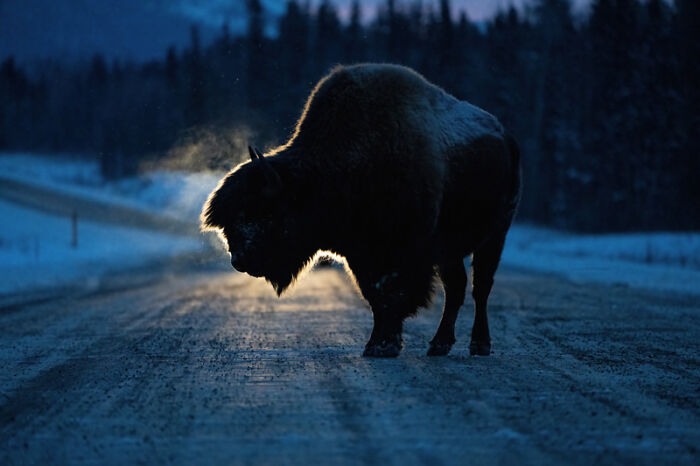
Image credits: Nature Photographer of the Year (NPOTY) 2023
#25 Category Youth: Runner-Up, "The Owls Birch" By Anton Trexler, Germany
"On my daily way to school, I always passed this tree where in autumn some long-eared owls spend their day. I have been photographing them after school for a long time. One day there was just one owl sitting perfectly in the birch. The vertical camera movement (ICM) creates white lines of the overexposed sky, which support the almost melancholy hanging branches of the birch as a pictorial element. The setting sun shines golden through the yellow-green foliage in some places. Because The Owl and its branch are darker than the rest of the tree, they didn’t appear blurred."
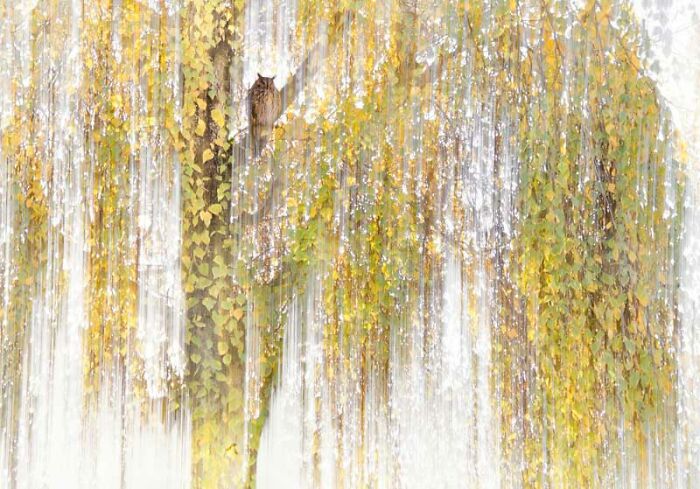
Image credits: Nature Photographer of the Year (NPOTY) 2023
#26 Category Underwater: Highly Commended, "The Marriage Of Moon Jellyfish" By Mayumi Takeuchi-Ebbins, United Kingdom
"This image is a huge crowd of Moon jellyfish. The female jellyfish will change her body color to pink or purple when she is ready for spawning eggs but not so many females there compared to male jellyfish. This moment is exactly when lots of male jellyfish are chasing only one pink bride in the crowd. I took this image from Prince William Sound in Alaska in June 2022. It was terribly heavy raining for a week while I was staying in Alaska and I couldn’t go out to the ocean for 4 days and I stuck in the town for a few days. On my last day, we decided to find the blossom of Moon jellyfish by 2 dives. I know there are some pink or purple female jellyfish there during summer in Alaska and I spent whole diving to find it. The first dive failed to find it and I could find only one pink bride in the crowd below 30 metres from the second dive. It was not easy to spot a pink bride out of a thousand male jellyfish and I was so lucky to find it. There was no sunlight by heavy rain and all jellyfish were trying to move down to deep water and I had only 5 minutes chance to shoot this moment. It was an incredible moment to see this behavior that all male jellyfish are chasing the pink female and surrounding her. I never forget this beautiful moment in my heart."
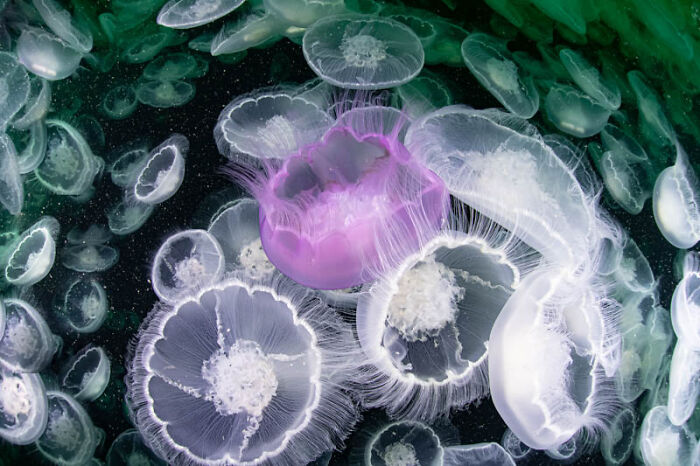
Image credits: Nature Photographer of the Year (NPOTY) 2023
#27 Category Animals Portraits: Winner, "The Pen And Inkwell" By Jonathan Lhoir, France
"This image of a pink flamingo was taken in the Camargue last winter. At certain times of the year and in certain places, the water level drops and the substrate becomes denser. Despite this, Greater Flamingos (Phoenicopterus roseus) like to come and look for food in this muddy water. It’s a great opportunity to observe and photograph them, because when they lift their heads out of the water, a thin film of mud clings to their plumage for a few seconds. It’s an image I’d been hoping to capture for a long time, and on this particular day, all the conditions were right: clear skies, light cloud cover, backlighting and, of course, the flamingos and the right level of water! Naturally, I called this image ’the pen and inkwell’."
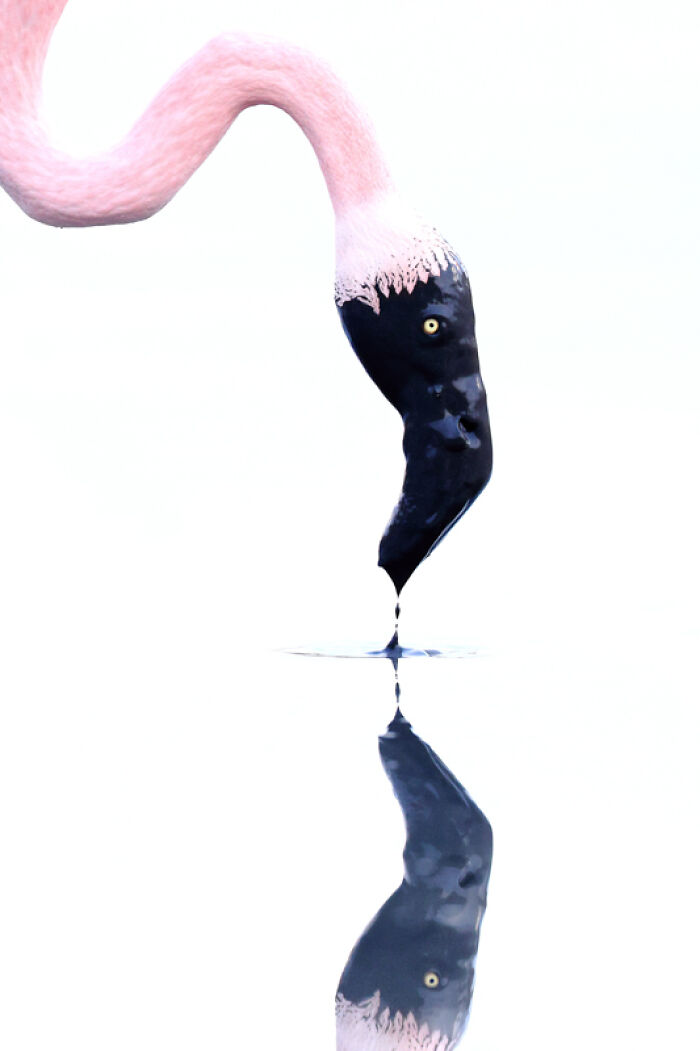
Image credits: Nature Photographer of the Year (NPOTY) 2023
#28 Category Birds: Highly Commended, "Hand Fan" By Manuel Enrique González Carmona, Spain
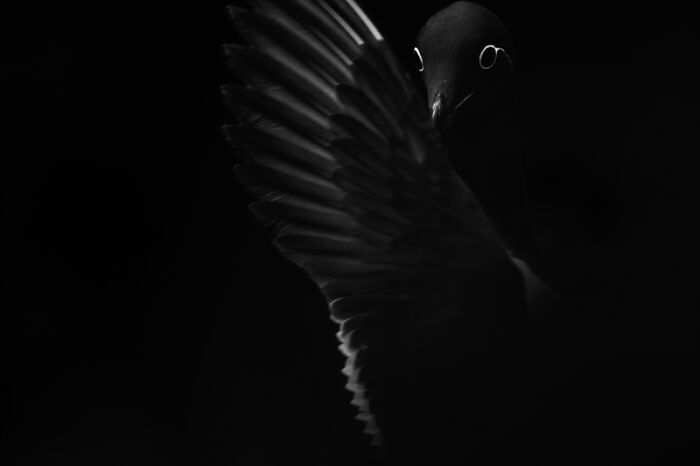
Image credits: Nature Photographer of the Year (NPOTY) 2023
#29 Category Human And Nature: Winner, "The Sad Poncho" By Xj Toh, Singapore
"Nautili are grabby little creatures known to latch onto passing jellyfish in the ocean. Based on my research, they do this as a mode of travel or for more devious reasons, like sneakily siphoning the jellyfish’s food for themselves. I did a double-take at how cartoonish this Nautilus looked when I first saw it. But it’s initial silliness hides a sobering truth: somehow, this Nautilus – despite living more than 20m underwater – had found this plastic packaging. I spoke to a few locals in Anilao (Philippines) about my experience after my dives, and this was what was shared with me. Families would dump their trash on a nearby mountain because of the inaccessibility of trash points. And when typhoons arrive, these heaps of plastic bags, styrofoam cups, food wrappers, and so on would be scattered by the winds into the ocean… and what was once used to store bread and treats for humans would be mistaken by these Nautili as their own food sources, not realizing that they’ve latched onto an empty inedible bag. Our minds often deceive us when we spot distant or obscure shapes, seeking familiarity in the unknown. When I first saw the Nautili with the plastic bag, my first thought was that it resembled a person in a torn poncho. It’s the mind’s way of interpreting limited information. I wanted to depict this quirky character to reveal a sobering truth – like a man with a torn poncho, this cartoon-looking creature is unable to escape the consequences of manmade ecological disasters and the wrath of nature. I observed the creature for a while, noticing its fearful, uncertain, and sorrowful demeanor. Its distress wasn’t due to my presence as a visiting diver, but rather, the harsh reality that it had no other option but to cling on to this desolate vessel for survival."

Image credits: Nature Photographer of the Year (NPOTY) 2023
#30 Category Animals Portraits: Highly Commended, "Master Of Camouflage" By Amit Eshel
"Wild Snow Leopard male, Spiti Valley, India. We found this large Snow Leopard male as he was looking for a cover during a snowstorm. His camouflage in the environment was simply amazing, If he hadn’t moved we would never have noticed him! I loved the textures and zig-zag shape of the snow-covered rocks and wanted to include it all in the composition even though I could get a tighter shot of the Leopard using a longer lens and a teleconverter. For me wildlife photography is firstly about capturing the Animal in the context of the environment."

Image credits: Nature Photographer of the Year (NPOTY) 2023
#31 Category Youth: Highly Commended, "Between Day And Night" By Anton Trexler, Germany
"Blackbird singing in the dead of night. Blue atmosphere and red moon. Standing up early before sunrise allows you to experience the magical awakening of animals. The blackbird is one of the earliest animals to wake."

Image credits: Nature Photographer of the Year (NPOTY) 2023
#32 Category Nature Art: Runner-Up, "The Ethereal Mist Of The Wicker" By Juan Lucas, Spain
"The red wicker fields, in Cañamaras, Cuenca, Spain, are a very unique visual spectacle. The land is not very large (just a small region), but it gives photography lovers a wealth of colors in autumn, being a great inspiration for the imagination. I took the photograph using the double exposure technique. One photo of the wicker fields and another photo of a sunset sky, specifically a cloud. With the double exposure, I managed to make it look like an unreal dense fog over the red fields."

Image credits: Nature Photographer of the Year (NPOTY) 2023
#33 Category Birds: Highly Commended, "Lost In Blooms" By Laura Becker, Switzerland
"I had the privilege to travel to the Falkland Islands for the first time in 2019. I was stunned by their rough beauty and the spectacular abundance of wildlife. So I felt I had to return for a longer time. In early 2020 I had the chance to spend three weeks roaming around bird colonies and observing their daily routines for hours. Every morning penguins would travel from their breeding colonies to the sea to catch food to provide for their young. Magellanic penguins bring up their chicks in burrows uphill which can be a few hundred meters away from the shore. So in the mornings, they make their way through the vegetation down to the beach. I loved the white sandy beaches on some of the islands decorated with beautiful yellow flowers of sea cabbage. So I laid down amongst them and waited for someone to pass by. This little fellow did, and I was quite happy with the composition. Also, I liked the little moment of confusion that is provoked by the sight of a penguin surrounded by flowers and white sand you could almost take for snow."

Image credits: Nature Photographer of the Year (NPOTY) 2023
#34 Category Nature Art: Highly Commended, "Black And Green" By Filippo Carugati, Italy
"Among the many stunning encounters on my last harping trip in Costa Rica, one of the luckiest was certainly with a black-speckled palm pit viper (Bothriechis nigroviridis). During a walk in the cloud forest of the Cordillera de Talamanca, after hours of maniacal searching, I finally spotted one individual on the ground basking in the sun. It was extremely difficult to spot the camouflaged viper in the colorful and dense pattern of mosses and epiphytes. From a zenithal point of view, I framed the twisted coils of the snake, enhancing the details of each scale and the resulting geometrical motif. The picture was taken in situ, without any manipulation or disturbance for the animal."
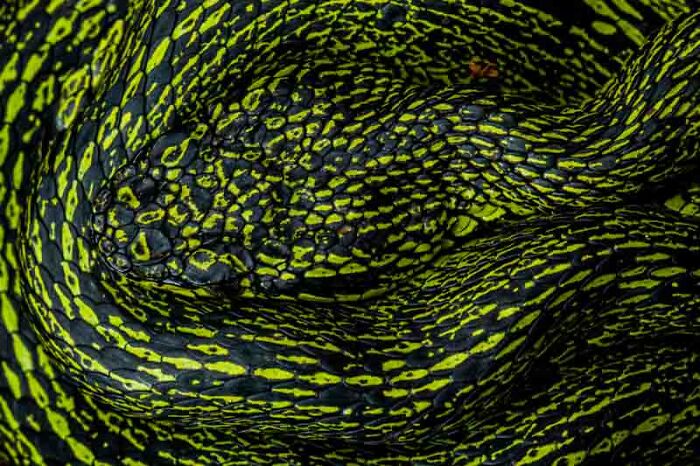
Image credits: Nature Photographer of the Year (NPOTY) 2023
#35 Category Nature Of “De Lage Landen”: Winner, "Big Wing" By Alex Pansier, The Netherlands
"For a long time, the black woodpecker was on my wishlist. I find the graphic bird with its red accent absolutely stunning! The challenge for me was to find one, and by chance, I stumbled upon a nest next to a bike path in the De Maashorst nature reserve in the Netherlands. Night after night, I stood at a respectful distance to see if there was any activity. The nest was quite high up in the tree, so I needed the distance to take a shot that gave a feeling of eye level—an intimate shot. That’s why I chose to use a 1.4x teleconverter on my 400mm lens. After a few evenings, I already had some fantastic shots, but I felt like something was missing. At the same time, I noticed that the sun was shining precisely between the leaves on the tree, as it was still early in the year and the trees weren’t fully covered in leaves yet. How beautiful it would be to play with the shadows that would blend perfectly into the black woodpecker. Now, the challenge was to time it so that the sun would illuminate just the head of the woodpecker without shining on the edge of the nest hole. That way, I would get a mysterious shot where only that lovely red cap, his eyes, and beak would be visible. Using my TPE (The Photographer’s Ephemeris), I was able to gauge the sun’s position, so I went a bit earlier in the following days. The exact moment should be at 16:51. Now, I just had to hope that the woodpecker would come out then. And luckily, a few days later, it happened. Around the scheduled time, a parade of cyclists passed by, after which the woodpecker curiously peeked his head through the hole. That was the moment I was able to take this photo. I was thrilled! When I got home, I immediately checked the catch on my computer. Yes, it was also sharply focused! And then, I also noticed the shadow on the light portion of the tree. It looked like a wing of the woodpecker. That was an extra bonus. That’s why I chose to name the photo ‘Big Wing'."

Image credits: Nature Photographer of the Year (NPOTY) 2023
#36 Category Underwater: Highly Commended, "Dancing In The Moonlight" By Andrea Michelutti, Itlay
"The picture was taken in the Lembeh Strait (North Sulawesi, Indonesia), one of the most popular destinations for underwater photographers. This small strait, constantly crossed by large container ships, hides rare and bizarre animals (the so-called critters). In the photo “Dancing in the Moonlight” I portrayed the Banggai cardinalfish, a species that inhabits a very narrow region of Indonesia. In their original habitat (the Banggai islands), they seek refuge among the spines of sea urchins to escape predators, but in the Lembeh Strait, where the long-spined sea urchins are scarce, they rely on anemones for protection. This is an Epibiosis: an advantageous situation for the fish and indifferent for the anemone. Since the Banggai cardinalfish has not developed a resistance to the venom of the anemones, it has to avoid touching the stinging tentacles, unlike the clownfish that can hide among them. Thanks to this particular behavior, I was able to portray these beautiful fishes in front of the anemone, whose tentacles can be glimpsed in the background, in a harmony of complementary colors."

Image credits: Nature Photographer of the Year (NPOTY) 2023
#37 Category Other Animals: Highly Commended, "Between The Stars" By Litauszki Tibor, Germany
"In Germany, where I live, there are many clean and slow-flowing streams nearby, which provide excellent habitat for Alpine newts. For years, I have been observing their lives closely, and this year was no exception. As soon as the frogs lay their eggs, a few days later, at dusk, the newts appear and feast on them throughout the night. Sometimes multiple newts compete for the same prey. I attempted to capture this moment underwater this year. To do this, I placed my camera in an underwater housing, secured it with weights, and positioned it beneath the frog eggs. At first, I was a bit nervous because I wasn’t sure if the underwater housing (Ewa Marine) was completely waterproof. But I thought that if no bubbles appeared, my camera would remain dry. I manually set the focus on the lens beforehand and relied on luck to ensure everything was in the right place. I waited nearby for it to get dark, and when the first newt appeared, I illuminated it with an LED lamp while exposing the shot. I initiated the camera using a homemade wired remote release. I spent four evenings with them this year, trying to capture the best possible shots. Unfortunately, there weren’t more days available because all the frog eggs were consumed, resulting in only 1-2 sharp images."

Image credits: Nature Photographer of the Year (NPOTY) 2023
#38 Category Plants And Fungi: Highly Commended, "Imaginary Creatures" By Gabriele Mannelli, Italy
"I have been traveling the world since I was a teenager, pursuing long-term photography projects. Mine is not a search for the perfect shot, but rather a search for the perfect emotion that gives birth to a good image. As it happens, this photograph was taken a few kilometers from home. We often focus on big issues far from where we live, losing sight of precious details around us. It was spring 2022 when I took this image which is part of a wide-ranging project, born completely spontaneously from a very strong emotional need within me. I had recently suffered a bad, false, and deceptive situation, which had completely destroyed me. So I returned to the natural pond located within the Foreste Casentinesi National Park, a place I have been frequenting for some years. That time I was able to see beyond the usual images. The pond is located within an old-growth forest with the oldest centuries-old chestnut and beech trees in Europe. Numerous amphibians and insects live in the body of water, but also very interesting aquatic plants such as the Potamogeton Natas immortalized in this photo. Each image contains a sensation, a feeling, this was the objective of the project, which lasted about two months."

Image credits: Nature Photographer of the Year (NPOTY) 2023
#39 Category Landscape: Winner, "Austfonna Ice Cap" By Thomas Vijayan, Canada
"The Austfonna Ice Cap ranks as the third largest in the world, situated on Nordaustlandet Island within Norway’s Svalbard archipelago. It spans an expansive 8,000 square kilometers and faces a disturbing rate of melting due to global warming. This accelerating thaw contributes significantly to rising sea levels, a grave concern for our planet’s future. During a recent visit to the Austfonna Ice Cap, I had the privilege of capturing a remarkable image of a waterfall formed by the melting ice. Despite having been to this location previously, it was disheartening to observe the sea ice had already vanished in June, allowing us to access the ice cap by ship. This year, the ice cap began melting earlier than usual, giving rise to this captivating waterfall. While the scenery held an enchanting allure, it simultaneously served as a stark reminder of the ice cap’s diminishing state, likely to vanish within a few years. This image is a composite of 26 frames, artfully stitched together to immortalize the transient beauty of this natural wonder."

Image credits: Nature Photographer of the Year (NPOTY) 2023
#40 Category Other Animals: Runner-Up, "Spider In Frame" By Minghui Yuan, China
"In summer, the leaves of Victoria Regia Lindl in the pond of Xishuangbanna Botanical Garden have been cleaned up by garden workers. On the shore, I found a water wolf spider on the back of a giant Victoria regia Lindl leaf. The leaf veins of Victoria Regia Lindl form various frame shapes. The water in the leaf vein frame is like a mirror, and the shape of the water spider forms a reflection in the frame. This is a combination of graphics, lines, and points. This kind of water wolf spider lives near the water, and sometimes they float on the water. This is due to their lightweight and dense hydrophobic hairs on their toes, which allow them to float and even run on the surface of water, supported by the surface tension of the water. Sometimes, the water wolf spider will dive underwater and form a large bubble and then rely on the air in the bubble to hunt and rest underwater. At this moment, the water wolf spider rarely emerged from the water. The moment when the spider occasionally came out of the water to breathe allowed me to see its whole body. When I found this water wolf spider resting in the leaf vein framework of Victoria Regia Lindl, I was careful not to disturb it. Slowly approach it and adjust the shooting position. The light is a little dark, so I have to increase the sensitivity and exposure. Although the shutter speed is a little slow, I was able to capture the subject clearly with handheld shooting."

Image credits: Nature Photographer of the Year (NPOTY) 2023
#41 Category Nature Of “De Lage Landen”: Highly Commended, "Pond Perspectives" By Alex Pansier, The Netherlands
"This season, I wanted to focus on tadpoles. There’s a small pond nearby teeming with these little frogs, making it a perfect spot to spend some afternoons. The idea was to photograph them from below. So, I brought along my underwater housing and tried various ways to get a shot from that angle. I set the white balance a bit cooler to emphasize the end of the day and narrow the aperture for more depth of field, so that you could better see the trees above the pond."

Image credits: Nature Photographer of the Year (NPOTY) 2023
#42 Category Youth: Winner, "Walk On The Hill" By Őrsi Ákos, Hungary
"During a bird-ringing trip with my friends to the Hungarian Tápióság, I saw these roe deer on the top of a hill next to us. As the sun was setting, my immediate thought was to capture a backlit photo, with very high contrast. There was not much time to make it happen, as in a few minutes all the light disappeared. The deer started walking around from one group, but they split up very soon. Just as I thought I missed the opportunity for an interesting photo, they regrouped again for a few moments."

Image credits: Nature Photographer of the Year (NPOTY) 2023
#43 Category Landscape: Highly Commended, "Inferno" By Radomir Jakubowski, Germany
"I was in the Vosges mountains working on my chamois project this autumn. The fog in the valley was beautiful, and I wanted to find another way to present this subject. The sunrise was beautiful red and the grass was illuminated by the first light of the day. I decided to shoot through the grass to get the warm light in the foreground and the fog was in the cool shadow. In that way, I created a cold/warm contrast looking like fire in the foreground."

Image credits: Nature Photographer of the Year (NPOTY) 2023
#44 Category Other Animals: Highly Commended, "Traffic Intersection" By Simone Baumeister, Germany
"I wanted to take pictures that evening. But without light, it’s difficult. So I went to a pedestrian bridge that offered a direct view of one of the main traffic intersections in our city. There were many spiders on the railing of the bridge. Using an old analog lens, I photographed the spider in front of the colorful lights of the city intersection with its many cars. The special shape of the lights comes from the fact that I had previously unscrewed the lens and turned one of the three lenses inside before screwing it back together. This way the lens is only sharp in the exact center and everything else becomes a twisting effect."

Image credits: Nature Photographer of the Year (NPOTY) 2023
#45 Category Nature Of “De Lage Landen”: Highly Commended, "Colors Of Destruction" By Karin De Jonge, The Netherlands
"I was photographing beautiful demoiselles along the “Rode beek” (Red Creek) in Limburg near Vlodrop. On the ground, I found the damaged wing of a beautiful demoiselle. I took it home where I had every opportunity to take a macro photo. I used a macro lens and two intermediate rings. First I wanted to use the studio flash but the backlight made the beautiful blue color disappear and the wing turned brown. Then I lit the wing diagonally from the front with a soft torch. It turned out there were lots of colors besides the beautiful blue color in that wing. For me, the image became more than a wing but one could see a spaceship or an apartment building in it. The damage, the hole in the wing, emphasizes transience and mortality."

Image credits: Nature Photographer of the Year (NPOTY) 2023
#46 Category Human And Nature: Highly Commended, "Post-War Chamois" By Filippo Carugati, Italy
"Over the last centuries, the Alps have been the theatre of many conflicts since they represent natural and political borders among different countries. For this reason, many valleys host remains of past wars, from Medieval castles to trenches and fortifications from the World Wars. During a winter walk in Val Varaita (Western Alps – Italy), I was exploring a snowy landscape when I spotted an Alpine chamois (Rupicapra rupicapra) licking the wall of a WWII bunker. This artificial construction was perfectly camouflaged on the rocky pattern of the slope partially covered by the snow. This peculiar behavior is probably connected to the assimilation of mineral salts and diet integration during the winter season when food is rare. I captured this scene including the surrounding pattern of vertical rocks to emphasize the peculiarity of the moment: remains of a war past now are peacefully reclaimed by nature."

Image credits: Nature Photographer of the Year (NPOTY) 2023
#47 Category Plants And Fungi: Winner, "Star Spangled" By David Maitland, UK
"Blue auto-fluorescing Star-shaped defensive hairs (Trichomes) covering the surface of a Deutzia leaf are silhouetted against the leaf’s red-fluorescing chlorophyll-packed cells. When exposed to invisible Ultraviolet light (but visible to insects etc.), plant Chlorophyll fluoresces bright red. All green plants fluoresce red while photosynthesizing, but its presence is too faint to be seen in broad daylight. Measurable fluctuations in this fluorescence indicate the plant’s health and ability to fix carbon. Environmental stress (e.g. heat waves, dry spells, flooding) brought on by Climate change can severely impair a plant’s ability to photosynthesize, and in turn, will impact crop productivity and food production."

Image credits: Nature Photographer of the Year (NPOTY) 2023
#48 Category Nature Art: Highly Commended, "Psychedelic" By Simone Baumeister, Germany
"I shot the snowdrops as a multiple exposure. The colored lights were created by my mobile phone with changing lights, which I positioned behind the flower. By changing the camera position and the color changes, this psychedelic rush of color was created. I had been trying to photograph snowdrops for years, but I was always dissatisfied with the results. So I wanted to try experimentally to create a slightly different photo. It took a few tries before I liked the distribution of the flowers as well as the color distribution."

Image credits: Nature Photographer of the Year (NPOTY) 2023
#49 Category Animals Portraits: Highly Commended, "Pelican Storm" By Alessandro Beconi, Italy
"Last year at the end of May, I went to one of my absolute favorite places. Grand Teton NP. The weather was very variable. Hot and cold, sun and rain. It was lunchtime that day, and I sat down by the river to eat a quick sandwich before heading back out to look for some animals. Suddenly a big snowfall came. I took shelter in the car watching the fishermen… the snow was falling so thick that I struggled to distinguish their silhouettes. Behind them I see a white pelican letting itself be carried by the river current. The situation was beautiful because the dark background of the forest highlighted the snowflakes. I closed the aperture to have as many well-defined snowflakes as possible. The moment passed very quickly, the pelican, as it appeared, disappeared in a few seconds."

Image credits: Nature Photographer of the Year (NPOTY) 2023
#50 Category Nature Art: Highly Commended, "Natural Colors And Reliefs" By Miquel Angel Artus Illana, Spain
"The image is a small example of the colors and reliefs that can be observed on all the slopes and mountains of the Puna, a large territory located more than 3,500 meters high in the North of Argentina, in the province of Jujui. The minerals of its mountains together with the native vegetation make it possible to observe incredibly beautiful colors and shapes. The image was taken in Puna de Atacama-Jujui-Argentina, where for ten days I toured its spectacular mountains. I made the trip only with a single camera and a single lens (Nikon D5- Nikon 300 f4) trying to make my movement the zoom that I did not have. I also dispensed with the blue sky in 90% of my photographs, because what I wanted to capture above all were shapes and colors and reliefs."

Image credits: Nature Photographer of the Year (NPOTY) 2023
#51 Category Birds: Runner-Up, "Long Necks" By Zakariya Omran, Bahrain
"At the end of 2018, after completing the production of the film (Babe of the Eastern Neighborhood), which talked about the desert owl and its role in preserving the ecosystem, I wanted to produce another film, this time about the Socotra cormorant, as the Hawar Islands are considered the largest colony of these birds in the country. The Middle East. Hawar Islands are located on the southern side of the Kingdom of Bahrain. They are protected military islands, and to be able to photograph Socotra cormorants on these islands, you need a permit for that, which is somewhat difficult. Therefore, I decided to search for other places where these birds breed in the islands of Bahrain because I know the Jarim Islands, which are three islands located north of the Kingdom of Bahrain and 20 kilometers away from the northern coast in the middle of the sea, and because I have also been visiting these islands since 2016 in the summer, where Tern and egrets breed on one of the islands, and since that year to this day I have been observing these birds in the summer. Therefore, I decided to search in the winter this time, knowing that Socotra cormorants breed in the winter, as these islands are considered a crossing point for many seabirds. When I arrived at the central island, I was surprised by a huge number of Socotra cormorants incubating their eggs, as I was the first to discover these birds breeding on this island. (Note that all bird photographers and interested people in Bahrain believe that the Socotra cormorant breeds only on the Hawar Islands. I have proven that there are other islands on which this bird breeds.) From the end of 2018 to 2020, I used to visit these islands during the breeding season of the Socotra cormorants, as the season begins from September to January, and these birds migrate to other regions after they begin to fly. I have not stopped visiting the Gram Islands since 2016, in the summer I follow the terns and in the winter the Socotra cormorants. At the beginning of the year 2022, everyone was surprised by news reported by the local press stating that the Al-Jarim area and the three islands in it would be transformed into industrial areas and tourist resorts. Then I decided to shed light on these birds that make these islands their home every year they breed. Hence the idea of this picture (with the length of the neck) came, meaning that these birds are observing the unknown fate that awaits them by turning these islands into tourist resorts. The idea was to photograph Socotra cormorants with a slow shutter while moving the camera up to reveal the birds’ necks, as if they were monitoring the place looking for any intruder who wanted to seize this space and turn it into a tourist resorts. Lately, for most of my photos, I use different shutter aperture techniques, depending on each photo and the subject I want to highlight in the photo. Therefore, I used the slow shutter technique in this photo, where I also moved the camera slowly from bottom to top, to illustrate the length of the necks of the Socotra cormorants."

Image credits: Nature Photographer of the Year (NPOTY) 2023
#52 Category Other Animals: Highly Commended, "Invisible Brookesia" By Petr Bambousek, Czech Republic
"During my expedition to Madagascar in 2022, I walked many kilometers through the forest in search of the local unique fauna. Many species use perfect cryptic coloration to survive, so it is advisable to have a good local guide with you. During the walk nearby Andasibe NP he pointed out to me that there was a beautiful specimen of Brookesia superciliaris on the ground ahead. These are tiny lizards that do not exceed 8 cm in length and their coloring blends perfectly with the dry fallen leaves on the ground. It’s so easy to overlook them. I decided to frame the photo in such a way as to accentuate their perfect camouflage with a wider composition including the surrounding foliage. In the picture, the lizard is often not visible at first glance, and its presence is all the more surprising. This exactly reflects my feelings about being in Madagascar, where I had the opportunity to observe many attractive species of animals, yet I am convinced that most remained hidden from my sight. All the more reason to visit this amazing island with endemic but critically endangered fauna."

Image credits: Nature Photographer of the Year (NPOTY) 2023
#53 Category Nature Of “De Lage Landen”: Highly Commended, "Information At Sunrise" By Karin De Jonge, The Netherlands
"With my nature photography club, 5 people from Limburg, I spent a few days in the province of Zeeland. We wanted to photograph the sunrise at Flaauwershaven near Kerkwerve so we were early on the scene. The sun did indeed rise very nicely. But then I looked over my shoulder and saw that the windows of the nature reserve’s information hut behind me had a strong orange glow. It looked like it was on fire! One window was broken and you could see the bird information cards through it. I found that very special. And so I took a bird photo without any living birds in it."

Image credits: Nature Photographer of the Year (NPOTY) 2023
#54 Category Landscape: Highly Commended, "Iceforms Around Pine Island" By Magnus Reneflot, Norway
"After a cold period at the end of November 2022, the ice froze solid on the small freshwater lake in Enebakk, 25 km south of Oslo. Vågvann is a lake with a low water level and good water circulation. A few days later the weather changed, and a thin layer of snow covered the ice. It became milder, the ice expanded and formed cracks with moisture over large parts of the snow-covered ice surface. The dark streaks of moisture became more and more numerous and some were as wide as roads. In recent years, this phenomenon has become more common than before. Climate change is causing several changes in weather from cold to mild. Frost, rain, and snow create unstable winter conditions, which can give us more opportunities to get similar conditions. For a photographer like me who is constantly looking for patterns in nature, I was very happy when I found this subject, although, of course, I am worried about the climate changes we are experiencing. The conditions were perfect with cloudy weather and little wind. It was just a matter of getting the drone up in the air and start looking for exciting compositions. Found this little island with snow-covered pine trees where the stripes had worked well together forming half circles around the island. Took many pictures this day and everything was constantly changing. The next day there were far too many stripes in the ice to find any interesting shapes and patterns to photograph. It is difficult to transfer experiences we have to others when we are out with a camera."

Image credits: Nature Photographer of the Year (NPOTY) 2023
#55 Category Plants And Fungi: Highly Commended, "Dandelions Lineup" By Alexey Korolyov
"Dandelions have a recognizable appearance. They are tall, and straight with a fluffy head. They grow close to each other and often form symmetrical and well-composed rows. Dandelions in the image are an example of such formation. Applying the in-camera multi-exposure function helped me to emphasize the concepts of rhythmicity and arrangement. When I photograph plants and flowers in particular, I am always trying to keep in mind their character and the associations my subjects evoke. This image is created using the in-camera multi-exposure function. Multi-exposure is often thought of as a toy that allows you to create fun special effects. However, it is a powerful tool for self-expression. It allows you to show in a single frame what you feel or think, but what you can’t technically capture in a single shot."

Image credits: Nature Photographer of the Year (NPOTY) 2023
#56 Category Other Animals: Winner, "December Moth" By Imre Potyó, Hungary
"We can find mushrooms not only in autumn, but some of them – for example, this antler-shaped fungus – also turn up in winter. The top of the 3-5 cm tall mushroom (Xylaria hypoxylon) branches multiple times, just like antlers. I have been taking photographs of spore clouds for 9 years. My picture ’December Moth’ was taken in last November in Börzsöny hill, Hungary. On a cold evening, I photographed this beautiful bouquet in flash backlight, when after dark – at only 1-2 degrees – December moth (Poecilocampa populi) suddenly fluttered around me in the litter. They just woke up and landed near my equipment and then on top of an antler-shaped fungus. Flashes flashed and he was walking and flapping his wings on the antler formations in backlight. The spores are spread by the currents, and from these, reaching further, new mushrooms can grow. These are unforgettable and tense moments for me. I believe that we can draw attention to the natural beauties with our impressive photos."

Image credits: Nature Photographer of the Year (NPOTY) 2023
#57 Category Landscape: Highly Commended, "Fadeaway" By Mauro Tronto, Italy
"The photo was taken in the Campo Imperatore plain, a vast plain located in the heart of the Gran Sasso and Monti della Laga National Park, in the Abruzzo region, Italy. This area is renowned for its natural beauty, especially during the winter and autumn seasons when the landscape transforms into a large theater capable of offering breathtaking shows. The shapes of the first snow settling on dark earthy ground can create an incredibly charming and magical image. At that moment I immediately had the feeling of being faced with a unique scenario. The contrast between the pure white of the snow and the color of the earth below created spectacular visual compositions. Reliefs, depressions, and details of the terrain emerged clearly, creating unique and exciting lines and geometric patterns. A sort of three-dimensional vision of shapes and surfaces that conveyed pure emotions to the eye of the camera."

Image credits: Nature Photographer of the Year (NPOTY) 2023
#58 Category Birds: Highly Commended, "Overflight" By Litauszki Tibor, Germany
"The photo was taken in Hungary last January. There are saline lakes near my hometown, which were frozen due to the cold. Some snow had fallen on them the previous night. However, during the day, the temperature rose above zero, causing the snow to start melting. As a result, fascinating formations formed on the ice. I planned to go out and start flying my drone above the lakes, searching for interesting shapes. I was amazed because wherever I turned the drone, I found great compositions. Suddenly, I noticed a dozen Greater White-fronted Geese flying beneath my drone; they couldn’t have been very far because the footage was almost unedited. Reflexively, I took a series of shots. At that moment, I knew it was an irreplaceable moment. I immediately reviewed the shots, and out of the series, only this one picture was acceptable. I was fortunate that the sun was shining brightly because it allowed me to use a short shutter speed. This way, the geese remained sharp, without any motion blur. I was thrilled that both the composition and the birds were in the perfect position."

Image credits: Nature Photographer of the Year (NPOTY) 2023
#59 Category Plants And Fungi: Runner-Up, "Spiral Galaxy" By David Maitland, UK
"The Margined Ramshorn pond snail (Planorbis planorbis) carries around a galaxy of photosynthetic single-celled algae, including Chlamydomonas and Micrasterias, living within a slimy biofilm covering the snail’s shell. The Chlorophyll within these unicellular algae shines bright red like stars within a night sky when illuminated by Ultraviolet light – a process called auto-fluorescence. The snail’s intestines are contrasted in shades of midnight blue. It is astonishing the diversity of “invisible life” that is all around us. I was amazed at the remarkable galaxy of microscopic life clinging to a pond snail’s back."

Image credits: Nature Photographer of the Year (NPOTY) 2023
#60 Category Plants And Fungi: Highly Commended, "Volcano Eruption" By Litauszki Tibor, Germany
"The photo was taken in Hungary in the Fall of 2022. One day, I was walking in the nearby forest with my little son when he noticed these small yellow mushrooms (Yellow Stagshorn) on a decaying log. I immediately thought of coming back here at dusk and trying to photograph them with backlighting. I saw great potential in the scene. I set up my camera on a tripod and used 2 flashes as a backlight. In the meantime, I illuminated them with an LED lamp to find the focus. It was then that I noticed a Crane fly (Tipulidae) flying towards the light of the lamp. I set the flashes to the second curtain, and thanks to the LED lamp, the flight phase of the mosquito became visible during the long shutter speed. Luckily for me, I got a picture where the mosquito and the small mushrooms were sharp. To capture the atmosphere of the twilight blue hour, during the in-camera multiple exposures, I turned the camera towards the canopy of the trees and moved it in a circle."

Image credits: Nature Photographer of the Year (NPOTY) 2023

